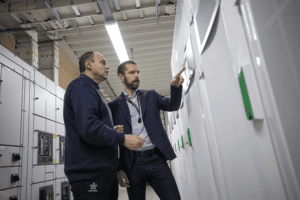As the Chief Technology Officer of the Swedish-based colocation provider, EcoDataCenter, my team and I have been focused on becoming one of the most sustainable data center facilities in the Nordic region.
When considering the requirements to creating a sustainable data center, our team simply could not ignore the facts. Experts had estimated that global data centers, including colocation, cloud and on-premise sites, consumed at least 205 TWh of energy in 2018. Because this is our industry, we also knew that rapidly growing demand for information services, for compute-intensive applications like AI and ML, and the ever-rising use of the internet would continue to drive this high energy use trend even higher.
This was one of the driving reasons why my company and I are so passionate about what we do. We want to be a part of this complex but worth-while effort, and work hard to implement new processes and technologies that dramatically reduce energy consumption.
EcoDataCenter’s Mission: Radically Lower Power Consumption
Recently, we achieved a power usage effectiveness (PUE) of 1.15 at peak conditions in one of our data centers which operates with a 2N toplogy. For comparison purposes, the average US data center’s PUE is 2.5, according to Uptime Institute.
At EcoDataCenter, we made it our purpose to change the way data centers are conceived, built, and operated with a focus on high sustainability. We look for solutions that not only manage costs, but also contribute towards the reduction of greenhouse gas emissions. We are aiming to be climate-positive, which means that the design of our data center as a part of the local energy system will offset the usage of fossil fuels by reusing our waste heat. We believe that our mission is important to us, our customers, and our community.
Leveraging Technology to Build a Climate-Positive Colocation Data Center
So, how did we build a climate-positive data center? We started with a focus on sustainability, which permeates all levels of data center design, from selecting high efficiency components to the way waste heat is recycled. For example, our data center sends surplus, low-grade waste heat to be used in the drying process of a nearby biofuel factory and pellet mill. The repurposed heat helps produce wooden pellets and the energy is thereby stored in the pellets and can be used during the colder months of the year. This is just one way that our local community, while also having a global impact.

Our approach to designing our new data center was highly focused, yet elegantly simple. Our engineers looked for solutions that would help manage energy usage while also planning for future growth capacity. We also chose to partner with key companies that could provide deep perspective and expertise in these same critical areas. Schneider Electric was one of these important partners and they worked closely with us, providing a variety of solutions to optimize operations and enhance sustainability. Integrating Schneider Electric’s EcoStruxure™ for Cloud & Service Providers platform into our new construction plans gave us the foundation necessary to achieve our goals. EcoStruxure’s open architecture enables us to seamlessly connect and integrate third-party hardware and software and to monitor the energy consumption of all our on-premise devices.
We are also considering using their analytics services, which would help our operators optimize energy use with precision, so that overall energy consumption can be kept to an absolute minimum. As a result, we would maintain highly competitive pricing due to our much lower operational costs.
EcoDataCenter’s Sustainability Colocation Data Center Story
The integration of innovative technologies was essential to our path to a climate-positive data center and achieving our mission. To learn more about the approach we took that yielded a low energy consumption infrastructure, check out our story.
About the author

Mikael is the Chief Technology Officer at EcoDataCenter. He is the former manager of the Regional Application Center for DataCenter in Nordics and Baltics, at Schneider Electric. Former project manager of construction projects for data centers, hospitals, oil rigs and chilled water plants in Europe, United States and Middle East. Accredited Tier Designer.



